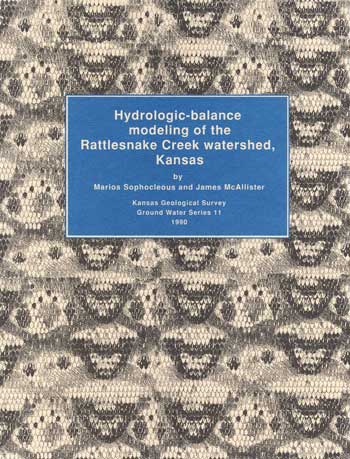Hydrologic-balance Modeling of the Rattlesnake Creek Watershed, Kansas
By Marios Sophocleous and James McAllister

Originally published in 1990 as Kansas Geological Survey Ground Water Series 11. This is, in general, the original text as published. The information has not been updated.
Abstract
A detailed but simple hydrologic budget for the entire Rattlesnake watershed (1,455 mi2) in south-central Kansas was developed. With this budget, using minimal daily-weather input data and the soil-plant-water system-analysis methodology, we were able to characterize the spatial distribution of the hydrologic components of the water balance within the basin. A combination of classification and meteorological methods resulted in a basinwide integration methodology. The classification method consisted of dividing the watershed into climatic subregions, grouping soil series into major soil associations, dividing each soil association into land-use classes such as irrigated and nonirrigated cropland and grassland, and finally superimposing a crop-rotation practice on the land usage. The meteorological method consisted of running a water-budget procedure repeatedly for each soil series, crop type, land-use practice, and climatic region combination. Area-weighted averages were then calculated to integrate the soil-plant-weather complexes on a watershed scale. Using this methodology, we found that, in addition to obvious climatic controls, soil, vegetation, and land-use factors also exert considerable influence on the water balance of the area. The available-water capacity (AWC) of soil profiles plays a dominant role in soil-water-deficit development and deep drainage. Vegetation and dryland or irrigated farming particularly affect the evapotranspiration (ET) components, with ET from irrigated corn and alfalfa being two to three times that from wheat. Deep drainage from irrigated wheat fields was found to be significantly higher than that from grassland and dryland wheat; deep drainage from alfalfa is practically nil. We demonstrated how vegetation changes may affect components of the hydrologic cycle. We also showed that different portions of the watershed have different water-balance components and that use of single-average values of hydrologic variables in management practices may not be realistic.
Kansas Geological Survey, Geohydrology
Placed on web Aug. 16, 2010; originally published 1990.
Comments to webadmin@kgs.ku.edu
The URL for this page is http://www.kgs.ku.edu/Publications/Bulletins/GW11/index.html